 Animals
Animals  Animals
Animals  Facts
Facts Ten Unexpectedly Fascinating Facts About Rain
 Crime
Crime 10 Dark Details of Australia’s Gruesome Unsolved Wanda Murders
 Humans
Humans 10 Unsung Figures Behind Some of History’s Most Famous Journeys
 Animals
Animals 10 Species That Refused to Go Extinct
 Weird Stuff
Weird Stuff 10 Weird Things People Used to Do at New Year’s
 Our World
Our World 10 Archaeological Discoveries of 2025 That Refined History
 Weird Stuff
Weird Stuff 10 Fascinating Facts You Might Not Know About Snow
 Miscellaneous
Miscellaneous Top 10 Things Crypto Was Supposed to Change & What Actually Did
 History
History 10 Huge Historical Events That Happened on Christmas Eve
 Animals
Animals 10 Strange Times When Species Evolved Backward
 Facts
Facts Ten Unexpectedly Fascinating Facts About Rain
 Crime
Crime 10 Dark Details of Australia’s Gruesome Unsolved Wanda Murders
Who's Behind Listverse?

Jamie Frater
Head Editor
Jamie founded Listverse due to an insatiable desire to share fascinating, obscure, and bizarre facts. He has been a guest speaker on numerous national radio and television stations and is a five time published author.
More About Us Humans
Humans 10 Unsung Figures Behind Some of History’s Most Famous Journeys
 Animals
Animals 10 Species That Refused to Go Extinct
 Weird Stuff
Weird Stuff 10 Weird Things People Used to Do at New Year’s
 Our World
Our World 10 Archaeological Discoveries of 2025 That Refined History
 Weird Stuff
Weird Stuff 10 Fascinating Facts You Might Not Know About Snow
 Miscellaneous
Miscellaneous Top 10 Things Crypto Was Supposed to Change & What Actually Did
 History
History 10 Huge Historical Events That Happened on Christmas Eve
10 Weird And Wonderful Libraries
Think libraries are boring?
Well, think again. Today’s libraries are a delightful combination of old school and high tech. Of course, libraries will always have great books waiting to be plucked from the shelves, but at many locations, you can also find free Internet, downloadable media, 3-D printing, and more.
Unfortunately, there are some parts of the world with no libraries at all. These people have little access to books, and you can forget about high-tech add-ons. So, what to do if you’re a bibliophile who lives in Burundi or on the plains of Mongolia?
To solve this problem, people had to think outside the box and some of their solutions will knock your socks off!
10 Books By Elephant
Some of the biggest library heroes are really big. Elephants are known for their size, memory, and excellent circus stunts, but who knew they could also be librarians? In the mountainous regions of Omkoi, Thailand, there are no schools or libraries and many people cannot read or write. The Books-by-Elephant program hopes to change that.
Many of these remote villages can only be reached by foot. In the rainy season, even that is difficult—but not for elephants. In Thailand, elephants are already used in rice paddy fields and the logging industry. It just took a little imagination to see that they could also carry books.
With specially built frames on their backs, these ponderous public servants can carry huge boxes of books along with video equipment and satellite dishes—whatever it takes to teach people to read.[1]
There are currently 20 elephants involved in the program. Each team is made up of two elephants, their trainers, and at least two teachers. These groups cover different areas and are able to reach out to more villagers every year.
9 Weapon Of Mass Instruction

Eccentric artist Raul Lemesoff created this particular weapon to battle ignorance and spread knowledge through the streets of Buenos Aires. His tank look-alike is made from a remodeled 1979 Ford Falcon.
The realistic-looking gun barrel and rotating turret ensure that people sit up and take notice wherever he goes. That’s fine with Lemesoff. The bigger the crowd, the more free books he can hand out. His only request: Read it, and pass it on.
His friends say he is one of those great crazy people that society needs. A poet, inventor, and artist, Lemesoff likes to combine these skills whenever possible. When he first started work on his weapon of mass instruction, no one was sure what he was making. Was it a spaceship or submarine, or was he just fixing his car? The end result was a delightful surprise.
With room for 900 books, Lemesoff can supply lots of readers, but his prime target is young people. He believes a young reader will be a lifelong reader. “I don’t do this for money or fame,” he said. “I do it because it’s fun. I attack people with knowledge but in a nice and funny way.”[2]
When Lemesoff’s weapon of mass instruction rolls into view, the shocked and ultimately smiling faces make his day. “The weapon of mass instruction is a peace tank,” he said, “a symbol of protest against real weapons of mass destruction.”
8 Biblioburros
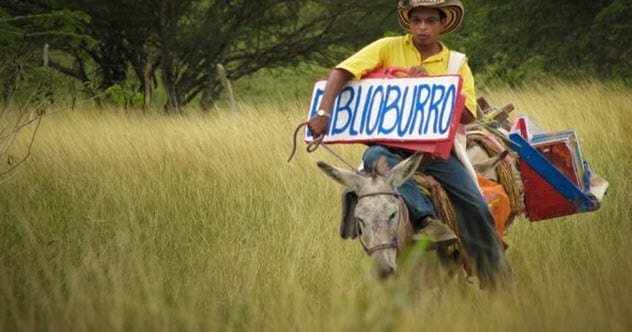
“Bibliomu-u-u-u-las,” the kids shout as their four-legged library approaches. The mules snort and stamp. But while they can be a little cranky, they seem to enjoy their job of spreading the love of reading.
Donkeys have always been used as pack animals, but now they have a special job—bringing books to the mountainous regions of Venezuela. Sponsored by the University of Momboy, an institution known for its community service, the biblioburros have changed the lives of countless villagers. These people reside in the Andes Mountains, and the climb to their homes is rugged.
The journey starts in the Valley of Momboy in Trujillo where the mules are loaded with books. For the next two hours, dedicated volunteers scramble up rutted paths in the sweltering sun.
Photojournalist James Ingham said, “These are just the foothills of the Andes, but they are high enough, especially when you’re walking.”[3]
According to the volunteers, the delighted faces of the children make it all worthwhile. In addition to bringing books to people, the university would like to provide Internet service. Their goal of installing wireless modems under the banana trees may sound far-fetched, but at one time so did biblioburros.
“Cybermu-u-u-u-las!” Why not?
7 The Levinski Garden Library
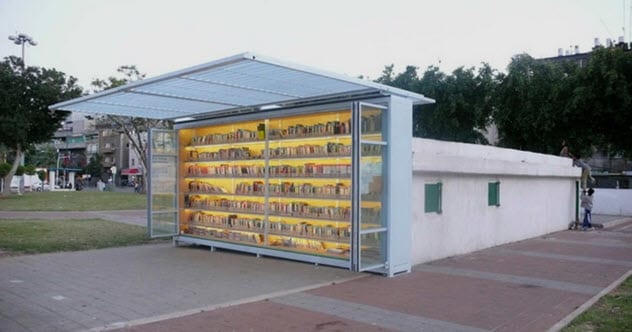
The Levinski library is located near the Tel Aviv central bus station in a community populated by refugees and migrant workers. Many of these people are not legal citizens, but the love of reading transcends the complexities of social status.
This is a simple library—no walls, just two shelves built against the side of a public shelter. Yet it is a place of learning and security, a designated safe house where no one is allowed to interrogate or intimidate.
The collection of 3,500 books comes in 15 languages from Mandarin Chinese and Amharic to Romanian. This outdoor facility is fitted with a canopy that swings out to protect books from the elements. There is a tall shelf for adults and a special reading area for children with panels that fold down to sit on. The facility is also lighted so that people stopping by after a hard day’s work can browse in the evenings.
The most unusual thing about this library is the filing system. Don’t look for the Dewey Decimal System here. These books are filed by the emotions they evoke in their readers.
Each book contains a file card where the reader notes his feelings about the book. Although one person may think it’s a nail-biter, the next reader may find it reassuring or inspiring. It’s a unique approach, but library patrons think the notes make each book more interesting.
Librarians at the Levinski project say it’s important for people to have a place to come and escape the hard realities of their lives. And as we all know, a good book is the perfect getaway vehicle.[4]
6 Human Library Living Books

Have you ever been to a Human Library? Here you can check out living books. These books are interesting people with stories to share. Readers check them out for 30-minute time periods, and that’s when the magic happens. At a Human Library, you can chat with people from all walks of life. Think former stripper, LGBTQ activist, or a journalist who was forced to flee his country.
The Living Books festival originated in Denmark in 1993. Due to a large number of immigrants, the social structure had changed and the old and new members of the community were not getting along. The first Human Library was aimed at giving people a chance to get to know each other, to sit down as neighbors, and break down barriers. It was a great success, and the concept of the Human Library has caught on.
“This type of library gives people a chance to talk with someone they wouldn’t ordinarily meet,” said the Imam of an Islamic society. “When you bring people from opposite ends of the social and political spectrum together in a nonjudgmental setting, a lot of good can come of it.”[5]
Human Library events are usually sponsored by library systems and community outreach programs. The whole idea is to get people talking and—most importantly—listening to each other.
The motto of the Human Library? Don’t judge a book by its cover.
5 Vending Libraries
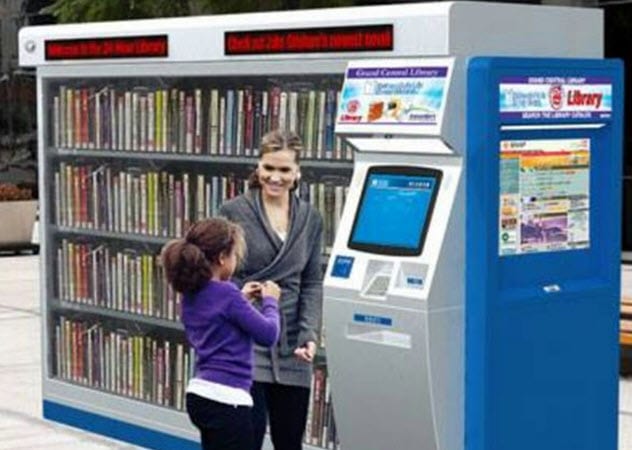
It’s 3:00 AM, and you can’t sleep. If only you had a good book to read. With library vending machines, you can hop into the car no matter what time it is and go check out a book. Similar to Red Box DVD dispensers, these self-service libraries are gaining in popularity. While they provide reading material to populations who can’t afford a regular library, they serve the public in other ways as well.
Vending libraries are popping up in high-traffic areas like park-and-ride lots, hospitals, and shopping malls. They’re also on busy street corners. Got a long layover at the airport? Get a book from the vending machine. Too time-crunched to stop at a regular library? Check out a title in the grocery store parking lot.
There are positives and negatives to this new technology. On the downside, vending machines have small collections and must be monitored carefully to make sure they are always full. Also, some people predict that downloadable options will make vending libraries obsolete.[6]
On the positive side, vending libraries are much cheaper than brick-and-mortar sites. They are mobile and can service remote populations. Many also provide Wi-Fi hot spots.
The first year after Contra Costa, California, rolled out their book vending devices, library circulation increased by 8 percent, which translates to 600,000 books. Bottom line for now, vending libraries get more books to more people.
4 Reading Club 2000
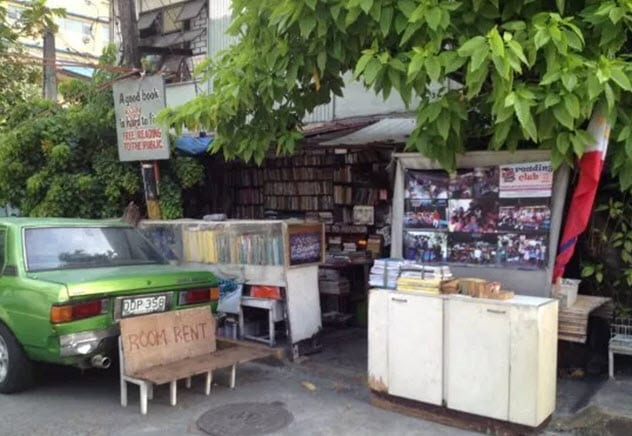
It was the year 2000 when Hernando “Nanie” Guanlao’s parents died. He wanted to honor them and soon realized the most cherished thing they had given him was his love of reading. As a legacy to his parents, he vowed to pass that love along to others in his community. So he started a library.
At that time, he had about 100 books in his home and wondered how he might share these with his less fortunate neighbors. To begin, he set his books outside with a sign indicating that they were for public use. He had no idea how people would react. Would the books be stolen? Would people even notice his fledgling library?
They did.
The books quickly disappeared and soon reappeared, along with donations of more books. Since then, his collection has multiplied. Guanlao now has 2,000–3,000 books and has become a middleman of sorts, donating books to other needy libraries when his collection grows too large.
In this library, there are no memberships, no due dates, and no late fees. If you can’t part with a particular book, you can keep it. The Reading Club 2000 currently offers everything from magazines and romance novels to philosophy books. Every day, a steady stream of people go home with a new book.[7]
3 Floating Books In The Fjords

If you’ve ever dropped your book in the bathtub, you know books and water don’t mix. But there is one exception. A book boat called the Epos traverses the rocky fjords of Norway, bringing light and learning during the dark Scandinavian winter.
The Epos is a 24-meter (80 ft) cutter that has been refurbished to hold 6,000 books along with a kitchen and living quarters for the crew. The book boat operates from September through April and makes two runs each year. During this time, it visits 150 coastal hamlets which are difficult to reach by traditional methods.
Norwegian winters are brutal, with dark days and howling blizzards. When the storms become too harsh, the book boat must hide out in a safe harbor. But this is a rare occurrence as there is great disappointment when the book boat fails to arrive. One of the requirements for the crew is immunity to seasickness.
The book boat keeps to a strict schedule. They arrive at a set time and stay for two hours at each location during which they receive up to 150 visitors. According to librarian Joep Aarts, the most eager borrowers are children and elderly people. Along with people’s selections, the book boat leaves a large package of books for people to enjoy until the next visit.[8]
The Norwegian government wants library services to be free of charge and available to everyone. The Epos makes that possible.
2 Camelback Library

“The walls of this reading room are made of mountains covered with forest, the roof is blue sky, the floor is a flower-covered steppe, and the reading light bulb is the Sun,” said Jambyn Dashdondog, the proprietor of the Camelback Library in Mongolia.
Over the course of 20 years, he covered 80,000 kilometers (50,000 mi) through rain and blistering sun. His employees were his wife and son, and transportation consisted of camels, oxcarts, and a cherished van.
In the early 1990s, the Mongolian government broke away from communism and subsequently lost funding for their libraries. Dealing in books and literature was not a profitable business, and in the new free-market economy, private investors were scarce.
An award-winning author himself, Dashdondog hated the idea of a society with no libraries. He decided if there was no place for children to get books, he would take books to the children.
When the library camel visited an area, Dashdondog would stay for a few days so that villagers had time to read their selections. Then everything was packed up and moved to the next outdoor reading room where children anxiously awaited his arrival.[9]
The camelback library and Dashdondog’s other literacy efforts were funded through the sale of his books and poems, some of which have been made into movies and songs. Sadly, Dashdondog passed away in 2017. He’ll not soon be forgotten, especially by the children.
1 Micro Libraries— Build Your Own
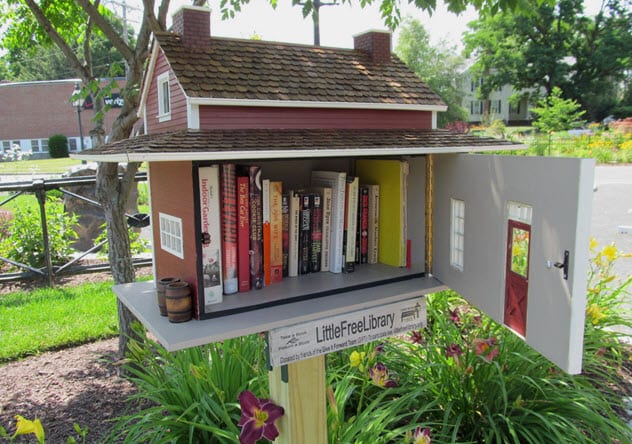
Do you love libraries? Now you can have one of your own just like 75,000 other people in 88 countries across the world. The popularity of this stripped-down version of Andrew Carnegie’s grand idea is growing by leaps and bounds.
Many tiny libraries are just for fun and manned by booklovers who want to share their love of literature. Others serve a vital purpose in inner-city neighborhoods and far-flung outposts.
When Todd Bol of Hudson, Wisconsin, saw a mini library in Portland, Oregon, in 2009, he decided to build one of his own. Modeled after a schoolhouse, the container was filled with books and placed on his front lawn as a tribute to his late mother. He went on to place several more around the city, and before long, the Little Free Library program was born.
Today, when people register their micro libraries at his website, they are included on the map of tiny libraries throughout the world. Also available are step-by-step instructions on how to operate your library. If you’re not a construction whiz, you can even buy premade boxes complete with Little Free Library signs.[10]
If you’d rather strike out on your own, go for it. All you need to do is fill your box with books, set it in a public place, and begin sharing the love of reading with the rest of the world.
A writer by trade and a wanderer by nature, I love to combine the two activities whenever possible. I’m also lucky enough to be a book lover who works in a library. You can find me at: The Library Lady Travels or the Library Lady Writes.
To read more fascinating facts about mysterious libraries, check out 10 Mysterious Libraries and 10 Lost Libraries And The Mysteries Of Their Contents.








